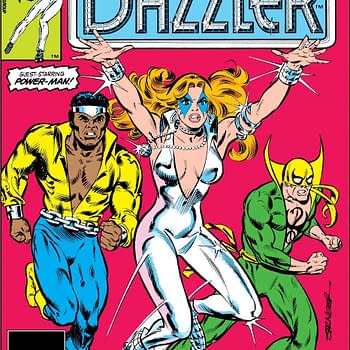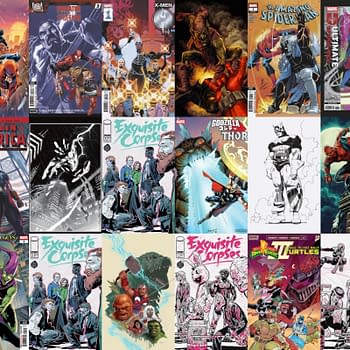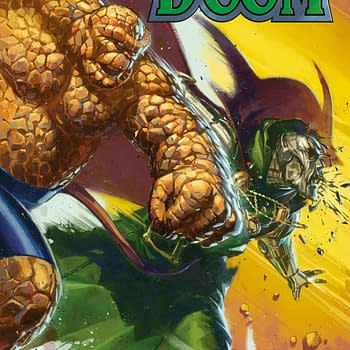Posted in: Comics, Recent Updates | Tagged: art history, brian k vaughan, Comics, Douglas Wolk, Drowning Girl, entertainment, fiona staples, roy lichtenstein, saga, The Mona Lisa, the pregnant moment, Whaam!
The Pictorial Narrative, Roy Lichtenstein And The Pregnant Moment In Saga
By Bart Bishop
Saga is the controversial space opera by Brian K. Vaughan and Fiona Staples. From the get-go it sparked scandal, specifically for a main character breastfeeding her baby on the front cover in the first volume. This is emblematic of what Brian K. Vaughan has mastered over his career, the "pregnant moment". This is a term used in academic criticism of visual arts, referring to a scene that tells a story in visual cues. Vaughan utilizes this methodology in his opening pages for the purpose of grabbing the reader's attention and enticing them to fill in the blanks. Although this practice has a long tradition, dating back to medieval religious iconography and even earlier, it was popularized in the 1960s by pop artist Roy Lichtenstein with his most famous works Whaam! and Drowning Girl. These are where Vaughan and artist Fiona Staples take their real inspiration. Two pages in particular stand out for their narratological storytelling in comparison to the written text or lack thereof: the openings of issues #4 and #5. These demonstrate Vaughan and Staples's provocative subversion of the audience's expectations of the "pregnant moment" while allowing the commonplace to be accepted under less than common circumstances.
Up until the renaissance, narrative painting was a common form of storytelling within the church. For the lay man or woman that could not read but still needed to be informed of the gospel, the church walls were adorned with pictorial narratives, "the rendering of specific events, whether mythological, legendary, historical or fictional, involving recognizable personages," according to theologian and historian Carl Kraeling in his "Narration in Ancient Art: A Symposium" (44). One such example is The Crucifixion with Scenes from the Passion and the Life of St. John the Baptist, attributed to Lippo de Benivieni circa 1315-20, that depicts the titular succession of events in triptych. The Renaissance, however, brought about a paradigm shift in painting, with virtually all works, "however specific or particular their actions, characters, place, or time–representing[ing] an event through an isolated moment" (Steiner 150).
This was more often than not the climax of a story and came to be known as the "pregnant moment", defined by Douglas Wolk in his Reading Comics: How Graphic Novels Work and What They Mean, as "a single image in static visual art […] from which time radiates in both directions, suggesting what's happened before and what's about to happen after," and functioning more symbolically or allusionary than narratively (131). "This was undoubtedly intended to arouse in the viewer's mind recollection of the complete story," says art historian Ann Perkins, "and in addition to stand as a symbol of the deeper lying ideas, beliefs, or physical orientation of the community" (55). This gave rise to ekphrastic painting that referred to temporal events without being strongly narrative. Take, for instance the English essayist Walter Pater's analysis of the Mona Lisa: 'The presence that rose thus so strangely beside the waters, is expressive of what in the ways of a thousand years men had come to desire. Hers is the head upon which all "the ends of the world are come," and the eyelids are a little weary. […] Certainly Lady Lisa might stand as the embodiment of the old fancy, the symbol of the modern idea' (98-99).
This all changed, however, in the 1960s with Roy Lichtenstein. Lichtenstein, one of the leading figures of the new art movement alongside Andy Warhol and Jasper Johns, started out as an abstract expressionist before transitioning into mimetic riffs on comic strip love and war stories. He used primary colors and what he called an "industrial painting" style, influenced as well by popular advertising, to create dramatic moments that demand to be extrapolated by the viewer. These were moments taken from actual comic books such as All-American Men of War and Girls' Romances, chosen for their depictions of clichéd gender roles, and then carefully reworked with cropping, elimination of detail, and deleting or editing of speech bubbles resulting in a highly charged effect.
Whaam!, for example, features an American fighter jet shooting down an enemy, accompanied only by the caption, "I pressed the fire control… and ahead of me rockets blazed through the sky…" and the sound effect for which it is named. How did the pilot find himself in this situation? His markings are clearly United States military, but who is his enemy? Is this his first kill, or his last? Does he survive the war, or even this battle? Drowning Girl, by contrast, is an extreme close-up of a teary-eyed young woman about to be pulled under by tumultuous waves, lamenting internally, "I don't care! I'd rather sink — than call Brad for help!" How did she fall into the water? Does she live or die? Who is Brad, and does he care or not? Redolent of the melodrama of the times, it exemplifies a cultural view of women that rely entirely on the help of men even in life or death situations and let their emotions overwhelm them while the former painting is a grim, terse moment of masculine violence and determination. With these paintings and others Lichtenstein reclaimed the "pregnant moment", grounding it in the temporal storytelling of the earlier pictorial narrative, while keeping the metaphysical aspects of post-Renaissance art. Not only is the audience encouraged to hypothesize what happened and will happen, they are invited to consider their own biases inherent in that hypothesizing.
With Saga, Vaughan and Staples harness the power of the "pregnant moment" while flipping it on its head. Inherent in the "pregnant moment" is it being the climax of a story, but Vaughan places these climaxes on the first page of his issues. Very rarely does an issue of Saga pick up immediately where it left off, instead showing the culmination of an entirely separate story that took place "off-screen" but serves as the catalyst for the resulting issue.
Take, for example, the first page of issue #4: set before a desolate background of purples and pinks are two monstrosities, women with only abnormally large heads set atop grotesquely long legs draped in fishnet stockings, with a strange glowing planetoid perched precariously above this sight. They're both simultaneously announcing, "Welcome to Sextillion!", as if they're speaking directly to the reader. Who are they talking to? What is Sextillion? Up until this point there'd only been the vaguest hint that one of the series' protagonists, The Will, was heading to this destination, but divorced of that much like Lichtenstein's work this splash page could be judged on its own. As a standalone image the fishnets are certainly evocative of more risqué women, and of course there's the name Sextillion that could leave no doubt about what goes on there. It's their form, however, presented with such nonchalance that implies this is a place of insidious decadence. The reader can't help but be intrigued, and can't help but jump to conclusions even before the page is turned.
Issue #4 is even more austere and paradoxical in its signifiers. The image is of a robot man with a television for a head wearing prestigious clothing reminiscent of Edwardian court apparel. He is sitting on a toilet with his pants around his knees reading a paperback novel. The conventionality of the moment, something most human beings have probably indulged in at some point in their lives, is offset even more by the fact that he's not in a stall but in a line of toilets out in the open. Taken at face value, one can assume that this is a society completely comfortable with exercising their bodily functions in public view, and there's also the quixotic question of what exactly does a robot defecate? Anyone familiar with the series so far would know this is Prince Robot IV, in pursuit of the leads Alana and Marko, and that the paperback he is reading is A Night Time Smoke by D. Oswald Heist, a thinly veiled political scribe hidden within the pages of a romance novel, the same book that brought Alana and Marko together. This mix of the bizarre and everyday grabs the reader and forces them to piece together a puzzle that Vaughan and Staples have laid out for them.
What both images have in common is their use of taboo subject matter. The former image and accompanying dialogue play upon clichéd fetishistic tropes with a distortion effect thrown in to unnerve the reader. The latter image combines ethos with a relatable location and situation but with a few minor details altered for comedic effect. Both pages play into Vaughan and Staples's thematic mission statement, to play around with familiar subject matter such as parenthood, sex and bodily functions hidden within the framing of a beloved sandbox like Star Wars but displayed in such a brusque way as to, ironically, make said subject matter more digestible. A comic book about such mundane issues might not be accepted by the standard comic book audience, but a veneer of sci-fi/fantasy and a flurry of shock value make it go down all the easier.
In a long tradition that highlights the power of visual storytelling in conjunction with or apart from the written word, Brian K. Vaughan and Fiona Staples have achieved something truly remarkable with Saga. They've taken lessons learned from history and Roy Lichtenstein's appropriation of the comic book and pushed that a step further, giving the reader stories in single images that not only force them to read on but pushes their imaginations to the limits, creating an engagement that makes the reader just as culpable in the storytelling process as the storytellers.
Works Referenced in This Article and Further Reading:
Kraeling, Carl H., ed. Narration in Ancient Art: A Symposium. Chicago: Oriental Institute, 1955.
Pater, Walter. The Renaissance: Studies in Art and Poetry: The 1893 Text. Ed. Donald L. Hill. University of California Press, 1980.
Perkins, Ann. "Narrative in Babylonian Art." Narration in Ancient Art: A Symposium. Ed. Carl H. Kraeling. Chicago: Oriental Institute, 1955.
Steiner, Wendy. "Pictorial Narrativity." Ed. Marie-Laure Ryan. Narrative across Media: The Languages of Storytelling. Lincoln: U of Nebraska, 2004.
Vaughan, Brian K., and Fiona Staples. Saga. Vol. 1. Berkeley, CA: Image Comics, 2012.
Wolk, Douglas. Reading Comics: How Graphic Novels Work and What They Mean. Cambridge, MA: Da Cap
Editor and teacher by day, comic book enthusiast by night, Bart has a background in journalism and is not afraid to use it. His first loves were movies and comic books, and although he grew up a Marvel Zombie he's been known to read another company or two. Married and with a kid on the way, he sure hopes this whole writing thing makes him independently wealthy someday. Bart can be reached at bishop@mcwoodpub.com.





















